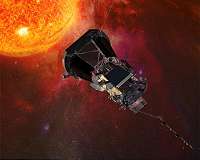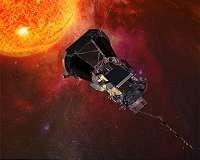
Parker Solar Probe teams up with Room observatories for 4th Experience (Image Credit: SNN)
In the center of knowing our area environment is the knowledge that states throughout space – in the Sun into the radiation environment in space that is deep into the atmospheres of planets – are connected.
Studying this link – a field of science heliophysics that is called – is a intricate job: Researchers track eruptions of substance, radiation, and allergens against the foundation of the outflow of atomic material.
A confluence of events at ancient 2020 generated a virtually ideal space-based lab, combining the alignment of some of humanity’s greatest observatories – like Parker Solar Probe, during its fourth atomic flyby – using a quiet period from the Sun’s actions, as it’s simplest to examine those background conditions. These requirements provided a exceptional opportunity for scientists to study how the Sun influences conditions at points through space, with angles of observation and at several distances from the Sun.
The Sun is the active star that the magnetic field is spread throughout the solar panel, carried over the Sun outflow of material called the solar wind, which contours the surroundings of worlds throughout the solar panel and impacts spacecraft. We have discovered other planets, space near Earth and the Sun, and even the very remote advantages of the Sun’s sphere of influence. And 2018 declared the launching of a new, game-changing observatory: Parker Solar Probe, using a plan to finally fly to about 3.83 million kilometers in the Sun’s visible surface.
Parker has now had four encounters of the Sun. (The data from Parker’s first encounters with the Sun has revealed a new picture of its air.) Throughout its fourth atomic encounter, spanning portions of January and February 2020, the spacecraft passed right between the Sun and Earth. This gave scientists a exceptional possibility: The wind which Parker Solar Probe when it was closest to the Sun, measured would arrive in Earth, in which the end itself and its consequences could be measured by both spacecraft and ground-based observatories. Moreover, solar observatories near and on Earth would have a perspective of the places on the Sun that generated the solar wind.
“We know from Parker data that there are particular structures arising at or close to the solar surface. “Ground-based observatories and other space missions provide encouraging observations which can help draw the full picture of exactly what Parker is observing.”
This alignment would be of interest but in addition, it coincided with a different period of interest to scientists minimal. That is the stage during the regular, roughly 11-year cycles of the Sun of activity if solar activity is at its lowest level – therefore abrupt eruptions on the Sun including energetic particle events, coronal mass ejections and solar flares are far less likely. And that means that studying the Sun near solar minimum is really a blessing for scientists who untangle which events cause which impacts and can watch a simpler system.
“This period offers perfect conditions to trace exactly the solar wind from the Sun to Earth and the planets,” said Giuliana de Toma, a solar scientist in the High Altitude Observatory in Boulder, Colorado, that led breeding among observatories with this monitoring effort. “This is a time when we can stick to exactly the solar wind more easily, since we do not have disturbances from the Sun.”
For decades, scientists have pulled together a scientist in the High Altitude Observatory, an attempt co-led by Sarah Gibson, observations through those phases of , and other scientists. For all of the three solar periods that are previous, info would be unveiled by scientists pooled observations via an ever-expanding collection of observatories in space and around the floor, trusting the abundance of data on the solar wind about the way that it evolves and forms. For this solar period, scientists started gathering coordinated observations beginning in WHPI for brief, ” or Planetary Interactions and ancient 2019 under the umbrella Whole Heliosphere.
This specific WHPI effort contained a broader-than-ever swath of observations: covering not just the Sun and consequences on Earth, but also data gathered in Mars and the character of space throughout the solar energy – everything in concert with Parker Solar Probe’s fourth and closest-yet flyby of the Sun.
The WHPI organizers brought together observers from all over the world – and – outside. Combining data in dozens of observatories on Earth and in space gives scientists a opportunity to paint what could be the most comprehensive picture ever of the solar wind: by pictures of its birth with solar telescopes, to samples soon when it leaves the Sun using Parker Solar Probe, to multi-point observations of its changing state throughout space.
– Advertisement –








